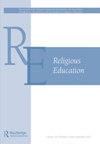Educating Black Girls Enduring Microaggressions in an Oreo World
IF 0.4
3区 哲学
0 RELIGION
引用次数: 0
Abstract
AbstractThe purpose of this article is to explore suburban Black Christian girls’ experiences of microaggressions in the public high school context. Through an ethnographic study, personal narratives were collected from six suburban Black Christian girls who all attended the same African Methodist Episcopal (AME) church where I served as the youth minister. These narratives offer insight into ways microaggression encounters in suburban schools can impact the personal identity, racial identity, and spiritual formation of Black adolescent girls. The Black sanctuary is the context where the girls in the study felt most accepted, represented, and safe. This implies re-imagining religious education practices with Black girls is important if pastors want to cultivate formative spaces that help Black youth thrive in an Oreo World.Keywords: MicroaggressionsBlack girlseducationChristianethnography Disclosure statementNo potential conflict of interest was reported by the author(s).Notes1 Dictionary.com, s.v. Oreo. https://www.dictionary.com/browse/oreo.2 According to the Chicago Public Schools “Understanding Special Education” webpage, a 504 plan is “a plan developed to ensure that a child who has a disability under the law (Section 504 of the Rehabilitation Act of 1973) and is attending an elementary or secondary educational institution receives accommodations and supports that will ensure their academic success and equal access to the learning environment. The disability must substantially limit a major life activity, which includes a child’s ability to learn in a general education classroom.” https://www.cps.edu/services-and-supports/special-education/understanding-special-education/#:∼:text=The%20504%20Plan%20is%20a,equal%20access%20to%20the%20learning. Accessed May 13, 2022.Additional informationNotes on contributorsGina A. S. RobinsonGina A. S. Robinson, PhD is at Wabash Center for Teaching and Learning in Theology and Religion, Crawfordsville, IN, USA. E-mail: robinsog@wabash.edu教育黑人女孩在奥利奥世界中忍受微侵犯
摘要本文旨在探讨公立高中背景下郊区黑人基督教女孩的微侵犯经历。通过一项人种学研究,我收集了六个郊区黑人基督教女孩的个人故事,她们都参加了我担任青年牧师的非洲卫理公会教堂(AME)。这些叙述为我们提供了在郊区学校遭遇的微攻击如何影响黑人青春期女孩的个人身份、种族身份和精神形成的视角。黑人庇护所是研究中的女孩感到最被接受、最具代表性和最安全的环境。这意味着,如果牧师想要培养帮助黑人青年在奥利奥世界中茁壮成长的形成空间,那么重新设想黑人女孩的宗教教育实践是很重要的。关键词:微侵犯黑人女孩诱奸基督教民族志披露声明作者未报告潜在的利益冲突。注1:Dictionary.com, s.v. Oreo。https://www.dictionary.com/browse/oreo.2根据芝加哥公立学校“了解特殊教育”网页,504计划是“制定的一项计划,以确保根据法律(1973年康复法案第504条)患有残疾的儿童,并在小学或中学教育机构接受住宿和支持,以确保他们的学业成功和平等地进入学习环境。”残疾必须严重限制一项主要的生活活动,其中包括儿童在普通教育课堂上学习的能力。“https://www.cps.edu/services-and-supports/special-education/understanding-special-education/:∼:文本= % 20504% 20计划% 20 % 20,等于% 20访问% 20 % 20 % 20的学习。于2022年5月13日生效。作者简介吉娜·a·s·罗宾逊,博士,就职于沃巴什神学与宗教教学中心,位于美国印第安纳州克劳福德维尔。电子邮件:robinsog@wabash.edu
本文章由计算机程序翻译,如有差异,请以英文原文为准。
求助全文
约1分钟内获得全文
求助全文
来源期刊

RELIGIOUS EDUCATION
RELIGION-
CiteScore
0.90
自引率
28.60%
发文量
46
期刊介绍:
Religious Education, the journal of the Religious Education Association: An Association of Professors, Practitioners, and Researchers in Religious Education, offers an interfaith forum for exploring religious identity, formation, and education in faith communities, academic disciplines and institutions, and public life and the global community.
 求助内容:
求助内容: 应助结果提醒方式:
应助结果提醒方式:


